2010 Indianapolis
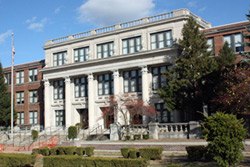
CTAUN Conference
Indianapolis, November 6, 2010
It’s Our World: Lessons for Peace and Reconciliation
Shortridge Magnet High School for Law and Public Policy
Welcome and Opening Comments
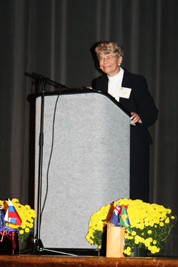 Anne-Marie Carlson, CTAUN Chair, welcomed all participants to the conference, the first CTAUN conference to be held in Indianapolis. She announced the theme, It’s Our World: Lessons for Peace and Reconciliation and explained the mission of CTAUN, Committee on Teaching About the United Nations as providing educators with opportunities to learn about the work of the UN and to incorporate global awareness into curricula and school activities at all levels.
Anne-Marie Carlson, CTAUN Chair, welcomed all participants to the conference, the first CTAUN conference to be held in Indianapolis. She announced the theme, It’s Our World: Lessons for Peace and Reconciliation and explained the mission of CTAUN, Committee on Teaching About the United Nations as providing educators with opportunities to learn about the work of the UN and to incorporate global awareness into curricula and school activities at all levels.
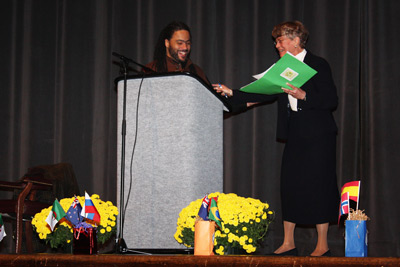 Brandon Cosby Shortridge Magnet High School for Law and Public Policy Principal, extended a welcome to his school to all participants. He shared the mission of the magnet high school to help prepare students for their roles as citizens and to explore social justice and legal careers. With the school’s focus on law and public policy students learn that “No Justice, No Peace,” and they must “Know Justice, Know Peace.”
Brandon Cosby Shortridge Magnet High School for Law and Public Policy Principal, extended a welcome to his school to all participants. He shared the mission of the magnet high school to help prepare students for their roles as citizens and to explore social justice and legal careers. With the school’s focus on law and public policy students learn that “No Justice, No Peace,” and they must “Know Justice, Know Peace.”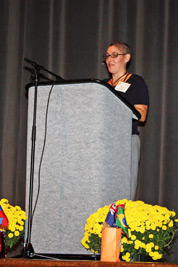 Daphne Draa, Art Teacher, Indianapolis Public Schools, invited all participants to be involved in the luncheon activity of designing a small peace sign magnet that would be used to construct large peace signs to be displayed during the closing celebration.
Daphne Draa, Art Teacher, Indianapolis Public Schools, invited all participants to be involved in the luncheon activity of designing a small peace sign magnet that would be used to construct large peace signs to be displayed during the closing celebration.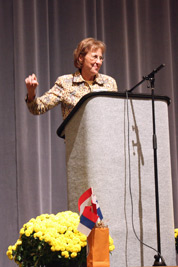 Faye Snodgress, Executive Director, Kappa Delta Pi, explained that Kappa Delta Pi, co-sponsor of the conference, has 42,000 members in twenty-three countries to promote excellence in education, community service, and global awareness. She announced that there were 310 conference participants registered representing six states from nineteen middle/high schools, seventeen universities, and twelve organizations.
Faye Snodgress, Executive Director, Kappa Delta Pi, explained that Kappa Delta Pi, co-sponsor of the conference, has 42,000 members in twenty-three countries to promote excellence in education, community service, and global awareness. She announced that there were 310 conference participants registered representing six states from nineteen middle/high schools, seventeen universities, and twelve organizations.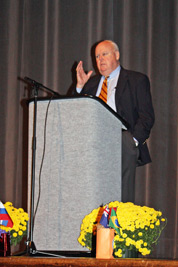 James Morris, Former Executive Director, UN World Food Programme spoke of how the world is becoming profoundly different and is changing with rapidity. He related how Lincoln’s quote, “I will prepare and some day my chance will come,” is very relevant today as thoughtful, caring, inclusive, trusting folks are needed to lead the way in today’s world. He said we should be judged on what we make of our opportunities, and we should see our opportunities in the largest context and exploit them positively. He encouraged the student members of the audience to study foreign languages and to take advantage of travel/study programs.
James Morris, Former Executive Director, UN World Food Programme spoke of how the world is becoming profoundly different and is changing with rapidity. He related how Lincoln’s quote, “I will prepare and some day my chance will come,” is very relevant today as thoughtful, caring, inclusive, trusting folks are needed to lead the way in today’s world. He said we should be judged on what we make of our opportunities, and we should see our opportunities in the largest context and exploit them positively. He encouraged the student members of the audience to study foreign languages and to take advantage of travel/study programs.During his work with the UN, he spent five years in Rome directing the largest hunger agency in the world overseeing 18,000 people. He sees hunger as the most serious issue in the world with 25,000 children dying each day of hunger/malnutrition. He reviewed the UN Millennium Development Goals and shared that he feels child hunger should be a primary focus and that for only thirty-five to fifty dollars a child can be fed for a year.
He talked of the importance of peacemaking, building relationships, and public diplomacy. He praised the contributions of Indiana institutions and individuals in their work of helping others as follows:
IU School of Medicine-working with HIV worldwide
Rotary Clubs-immunizing two billion against polio
Riley Hospital-sending doctors all over the world to perform operations and to train doctors
US Representative Andre Carson-contributing to fighting world hunger
US Senator Richard Lugar, Shortridge High School graduate-contributing to nuclear disarmament
He challenged participants to make the most of everyday, take advantage of opportunities, and ask, as Dr. Martin Luther King suggested, “What have I done for somebody else today?”
Panel Discussion The United Nations: The Dream and the Reality
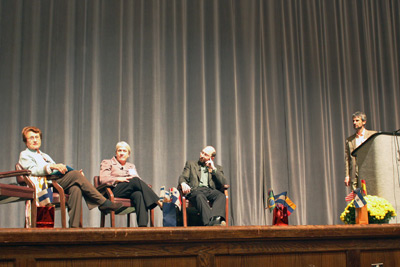 Charlie Wiles, International Interfaith Initiative Program Director, served as moderator and spoke of the faith dimensions of the UN in its role to enhance a culture of peace. He shared that understanding and skills are required to respect human rights, provide gender equity, appreciate cultural diversity, and protect the integrity of the earth. Groups must determine where their interests align to facilitate collaboration to meet millennium goals.
Charlie Wiles, International Interfaith Initiative Program Director, served as moderator and spoke of the faith dimensions of the UN in its role to enhance a culture of peace. He shared that understanding and skills are required to respect human rights, provide gender equity, appreciate cultural diversity, and protect the integrity of the earth. Groups must determine where their interests align to facilitate collaboration to meet millennium goals.
Cora Weiss, President of the Hague Appeal for Peace, spoke of the role of the UN in its sixty-five years of existence in creating a culture of peace. She spoke of three United Nations initiatives–eradication of render pest in cattle, Security Council Resolution 1325 which focuses on women, peace, and security, and the human right to peace. As a summary of the primary goal of the UN, she paraphrased poet Eve Merriam’s quote by sharing Cora’s dream that our daughters’ granddaughters will ask, “Mommy, what was war?”
Pierre Atlas, Global Studies at Marian College, talked of the role of the UN in the Middle East and shared the history of the division of land (UN Resolution 181) claimed by both Arabs and Jews. He spoke of renewed efforts by the UN including GA/9655 to make the dream of peace between two democratic states, Israel and Palestine, a reality. He invited participants to Marian College for a November 12 presentation by former US Secretary of State, Madeleine Albright.
Mary Grabianowski, Zionsville teacher and Model UN sponsor, shared that students who are involved in Model UN learn by doing through their participation, researching, speaking, and developing thinking skills. Model UN for high school students is an academic simulation of the United Nations. Participants research a country, take on roles as diplomats, investigate international issues, debate, and then develop solutions to world problems. Earlham College hosts the annual Model UN in Indiana.
During the questions and answer period, advice from Cora was given that to get a job at the UN, one should consider studying abroad, studying at least two languages, joining the peace corps, and becoming involved in service organizations such as Rotary, Kiwanis, faith communities, and NGOs.
Mariatu Kamara
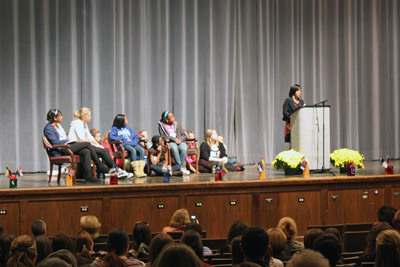 Inviting the students in the audience to join her on stage, Mariatu Kamara, war survivor and author, shared her life’s journey to reconciliation. Four years old when civil war began in Sierra Leone, she lived with an aunt in a village initially far from the war. The war, however, reached her tiny village–her home was set on fire, most of the captured villagers were killed, and she and three cousins had their hands cut off by soldiers. Years later including time in the hospital and three years in a camp, she had an opportunity to go to Canada at the age of sixteen. With no formal education and knowing no English, she started her education in ESL classes and credits theater groups in helping her to acclimate and to come to terms with her experiences.
Inviting the students in the audience to join her on stage, Mariatu Kamara, war survivor and author, shared her life’s journey to reconciliation. Four years old when civil war began in Sierra Leone, she lived with an aunt in a village initially far from the war. The war, however, reached her tiny village–her home was set on fire, most of the captured villagers were killed, and she and three cousins had their hands cut off by soldiers. Years later including time in the hospital and three years in a camp, she had an opportunity to go to Canada at the age of sixteen. With no formal education and knowing no English, she started her education in ESL classes and credits theater groups in helping her to acclimate and to come to terms with her experiences.
She said that God took away her hands so she could search the world with her heart. She refers to herself as a survivor, not a victim, who chose forgiveness, rather than bitterness, anger, and revenge. This decision has allowed her to feel peace and to move forward. She says we always have two choices–the positive or the negative. Her message conveyed her belief that forgiveness is the most precious thing in life. Currently in university in Toronto, she hopes to work for the UN and to establish a home for women and children in Sierra Leone who are victims of war or abuse. Copies of her book, The Bite of the Mango, were available for purchase. Her website is www.mariatufoundation.com.
Cora Weiss
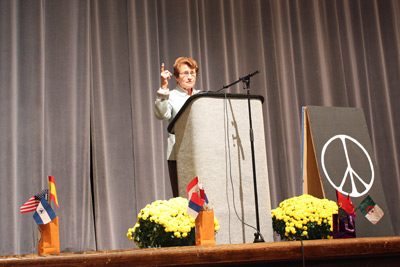 As participants entered the auditorium, they were greeted with the recording “Peace Train” by Cat Stevens and a display of many large peace symbols constructed from the diverse individual peace signs that they had made during the lunch hour.
As participants entered the auditorium, they were greeted with the recording “Peace Train” by Cat Stevens and a display of many large peace symbols constructed from the diverse individual peace signs that they had made during the lunch hour.
Cora Weiss first expressed her appreciation for the poster session contributions by preservice teachers from Indiana colleges and expressed her intent to ask permission to include the accompanying lesson plans on her website. She believes that to reach peace, we must teach peace. Students must be led to learn of democracy, non-violence, and traditional peace practices. She shared Sandra Day O’Connor’s website www.icivics.org designed to teach students, through interactive games, civics and inspire them to be active participants in our democracy.
She spoke of the increasing role of women in the UN and in world governments. The UN is celebrating the tenth anniversary of Resolution 1325. Though not fully implemented, this resolution urges that women be heard, recognized, and given a seat at the table of decision making especially in regards to peace and security. Expressing her long-held passion for peace, she used General William Tecumseh Sherman’s words: War is cruelty, and you cannot refine it. She urged participants to watch HBO’s War Torn. Her organization’s website is www.haguepeace.org
Closing Celebration
Door prizes contributed by supporters and steering committee members were awarded to participants through a drawing. Participants were given certificates of attendance and were reminded to put their individual peace signs in prominent locations as a reminder of the lessons of the day.
Summaries for Breakout Sessions at CTAUN Conference
Workshop Session 1: Building Awareness
The Power of Children: Making a Difference
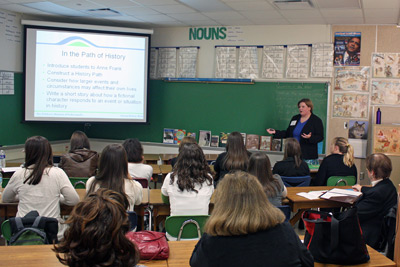 Presenter: Melissa Trumpey
Presenter: Melissa Trumpey
School Programmer at The Children‟s Museum of Indianapolis
The Children‟s Museum has temporary exhibits on Anne Frank, the Ryan White Collection and Ruby Bridges. The purpose of these exhibits is to help children understand and fight discrimination. Exhibit components include 1) history path and artifacts; 2) recreation of Anne‟s Annex, Ryan‟s bedroom and Ruby‟s classroom; 3) live theater performances of each story; 4) activity space with more information, artifacts, and interactive activities. The exhibit is age
appropriate as follows: Grades 3-5, Ruby Bridge–An introduction to the concept of segregation; Grades 6-9, Anne Frank—Facing Hatred: Daring the Dream; Grades 10-12, Ryan White—A boy who wanted to be like every other kid.
Visitors come away from these exhibits considering the roles and responsibilities of citizens in a democracy and how they can make a positive difference in their own communities.
Child Soldiers & Youth Peacemakers
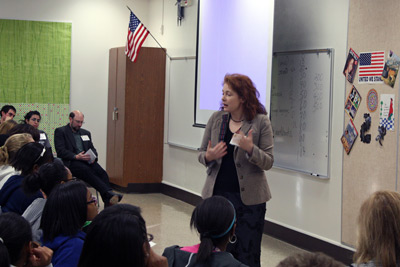 Presenter: Siobhan McEvoy Levy, Ph. D.
Presenter: Siobhan McEvoy Levy, Ph. D.
Associate Professor of Political Science and Peace Studies, Butler University
Dr. McEvoy Levy encouraged participation by asking the questions—who is a child? Who are child soldiers? Why do they join a violent group? and Do we have child soldiers in Indiana? The designation of “child soldier” was expanded to include recent immigrants to the US (possibly a child soldier in their native country), gang members and ROTC members. Reasons for all joining these groups were cited as economic, security and safety, protection for family and self and gaining a sense of belonging. Members of child soldiers groups are often recruited for the services they can perform.
Peace building employed four components: waging conflict nonviolently, as in marches and sit-ins; transforming relationships, preventing direct violence, as in providing youth centers; and training oneself and others to act nonviolently. Participants were invited to get involved locally in peace building.
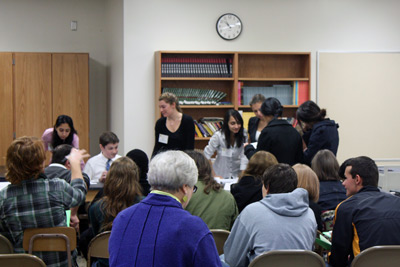 High School Model UN—It’s Fun! (Yes, really it is!)
High School Model UN—It’s Fun! (Yes, really it is!)
Presenter: Mary Scifres Grabianowski with students from Zionsville High School Model United Nations
Teacher at Zionsville Community High School for 20+ years
Ms Grabianowski introduced the history and workings of the Zionsville Model UN Program. Her students then modeled a UN session by discussing piracy in Somalia. Students represented UN member countries. Both moderated and unmoderated discussions were modeled as was the development of a working position paper and moderated discussion of the paper. A Model United Nations Conference will be held at Earlham College on January 28-29, 2011. For more information www.earlham.edu/MODELUN/ .
Anne Frank in Rwanda
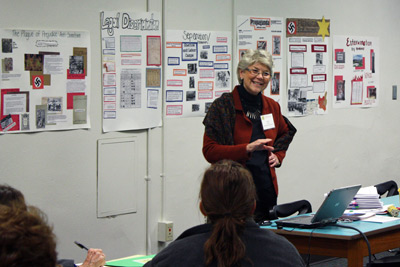 Presenter: Sarah Powley
Presenter: Sarah Powley
English Department Chairman, McCutcheon High SchoolMs Powley took the group through an abbreviated version of the week long unit she teaches to her 9th grade English classes. Using historical and geographic information, the class analyzes the progressive development of a government‟s systematic isolation and eventual murder of one segment of the population by their fellow citizens.
Collegiate Poster Session
Presenters: Indiana Reading Association College Professors with preservice teachers
Posters created by various college preservice teachers were displayed highlighting books encouraging peace and conflict resolution. Lesson plans to accompany each book prepared by the preservice teachers were available for participants. Please see end of this report for an exhibit of posters
Civil Society – Essential for Social Change
Presenter: Cora Weiss
President, Hague Appeal for Peace
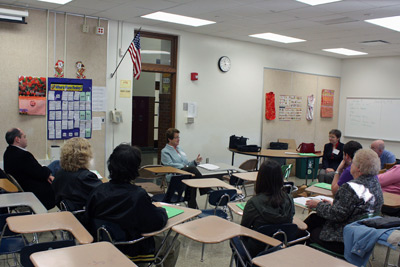 Cora Weiss provided an overview of a civil society and discussed examples and projects. A civil society is not a government or an organization. A civil society includes people and non-profit institutions. It monitors government and is the “eyes and ears” all over the world. A civil society is essential to democracy and communication. One example provided was the treaty on nuclear fall-out signed by John F. Kennedy and the Soviets. The treaty was a result of civil society efforts by women who noticed that children’s teeth were showing the effects of nuclear fall-out.
Cora Weiss provided an overview of a civil society and discussed examples and projects. A civil society is not a government or an organization. A civil society includes people and non-profit institutions. It monitors government and is the “eyes and ears” all over the world. A civil society is essential to democracy and communication. One example provided was the treaty on nuclear fall-out signed by John F. Kennedy and the Soviets. The treaty was a result of civil society efforts by women who noticed that children’s teeth were showing the effects of nuclear fall-out.
Workshop attendees shared their civil involvement. UNICEF provided a disaster relief project by sending “a school in a box.” Disasters take away “all,” providing a time to make some peaceful changes while bringing people together. They “promote togetherness.” Peace Education/Counseling in Uganda was formed to help children by placing trained counselors in schools. A three-volume curriculum for peace education is available at www.haguepeace.org.
Uplifting Impoverished Communities
Presenter: Kelly Campbell
Co-Founder of The Village Experience
Interns: Matt Steele, Maggie Hubert, Karrah Wood, Sarah List, and Kristen Tjaden.
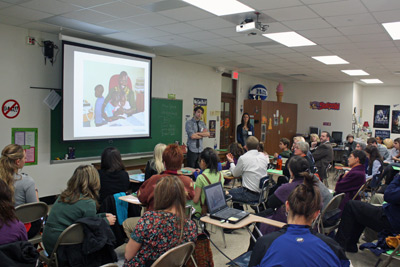 The Village Experience sells fair trade objects. Fair trade empowers the workers. By purchasing a quality project, someone else can be helped. In addition to the shop, the program sponsors socially responsible trips. Primarily to Kenya, the trips allow travelers to see where their fair trade objects are made. They empower the community by using locally owned business for tours, etc.
The Village Experience sells fair trade objects. Fair trade empowers the workers. By purchasing a quality project, someone else can be helped. In addition to the shop, the program sponsors socially responsible trips. Primarily to Kenya, the trips allow travelers to see where their fair trade objects are made. They empower the community by using locally owned business for tours, etc.
The Village Experience tries to provide sustainable assistance. They help create vocational skills rather than just give money. As an example, a community wanted money to pay for a teacher so their children could go to school. Instead of providing money that would only provide a short-term solution, The Village Experiences researched the area. They discovered that eggs were expensive due to transportation costs. They built chicken coops in that community and empowered the people to have chickens. The people in the community were then able to produce their own eggs. This decreased the costs of the eggs and the profits were enough to enable them to pay for a teacher’s salary. The salary is therefore supported in a sustainable way.
The travel agency also has interns. Matt, a sculptor, spent three months in Kenya helping people refine their skills for making paper beads. The cost to make a strand is $1. The Village Experience pays $5-$6 per strand and sells them in the U.S. for $20. The money made goes back into the non-profit. Kara worked in Asia with a group while staying in an orphanage. Her challenge was to find a way to make goods that are appealing to a Western market. Western markets want consistency in a product. The group had available to them lots of fabric. She assisted them in designing ID holders. A pattern sized for western ID/cards was designed. This provided a sellable and consistent product.
The group also discussed the advantages and disadvantages of fair trade. Some of the disadvantages included the following: having to use what is there (limited in choice of materials), language barrier, inconsistency of product. Advantages included the following: alleviates poverty, provides access to the Western market, and is sustainable/eco-friendly.
Workshop Session II: Getting Involved
We’re Building Tomorrow, Wanna Help?
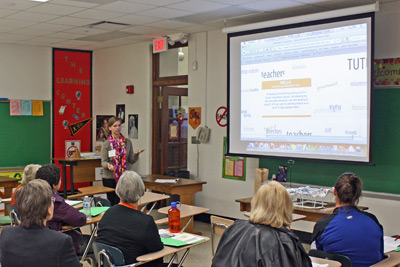 Presenter: Liz Brade, Fundraising and Development Director, Building Tomorrow, Inc.
Presenter: Liz Brade, Fundraising and Development Director, Building Tomorrow, Inc.
Participants (divided into two groups) were given 7 minutes to build a school with a bag of materials provided by the presenter. One group was given 50 times more materials. Then participants were asked to envision the worst school they could imagine. When photos of schools in Uganda were shown participants realized these schools were much worse than they had imagined.
Uganda has signed up for Universal Primary Education (A goal of the UN is that children everywhere will be able to complete a full course of primary schooling.) That is why Building Tomorrow is in Uganda. In order to achieve this goal, many classrooms need to be built. Helping are 26 college chapters of Building Tomorrow (throughout the US). Fund raising has also been done in some high schools.
Using Martial Arts to Help Troubled Youth
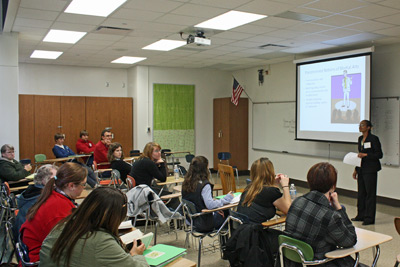 Presenter: Sheri Anderson
Presenter: Sheri Anderson
Assistant Professor, Department of Teacher Education, University of Indianapolis
Dr. Anderson described a pilot research program in Baton Rouge, LA,which she hopes to bring to Indiana in a year or so. Called “K-STAND (Kick Start To A New Day) it is directed to 5-8th graders designated as emotionally or behaviorally troubled. Through disciplined physical activity (Taekwondo), the youngsters learn and practice courtesy, integrity, perseverance, self-control, and indomitable spirit, as well as specific physical skills. Findings so far are that the children do better academically, have fewer behavioral infractions, show a better disposition and have happier parents and guardians the following school year.
The pilot program has been held in the summer for the past two years in Baton Rouge.
Peaceful Classroom Communities: Building Learning Environments that Embrace Everyone
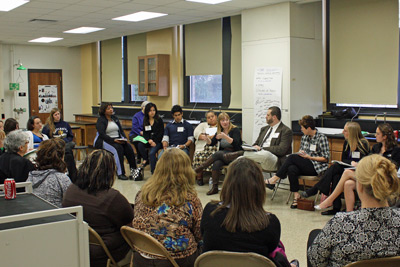 Presenter: Kirsten Eamon-Shine
Presenter: Kirsten Eamon-Shine
Youth Services Director, Peace Learning Center
Participants were told a story one sentence at a time and asked to react after each sentence/how did it affect them? This was done to illustrate that we all experience what we hear differently and that how we react changes when we hear the “whole story”.
There are three „Pillars of Peace‟: Aspects of a peaceful community: 1) Emotional Management which includes emotional awareness, emotional control and empathy, 2) Healthy Communication includes apology and moving from debate to dialog, and 3) Collaborative Problem Solving which is knowing how to work together well and focusing on solutions not problems. Discussion centered on how to teach each of the three pillars.
Shortridge Student Court
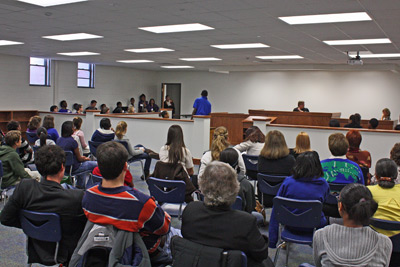 Presenter: Brandon Cosby
Presenter: Brandon Cosby
Principal, Shortridge Magnet High School
Shortridge Magnet High School is an economically challenged school with high attendance (98%). The school practices a system of democracy, using a student jury for corrective action. The students are productive voting members who are educated and well-informed. Students may earn up to 30 hours in college credit and all students are required to take one law class. Students are chosen for jury duty in the student court. A “mock trial” is used for student discipline. A case example provided was bullying. If a student is found guilty by the jury of peers, the sentence sticks! A sentence may be community service, separating students into different classrooms, writing essays, etc. Overall, the court/jury program is a very positive learning experience.
Teaching Non-Violence
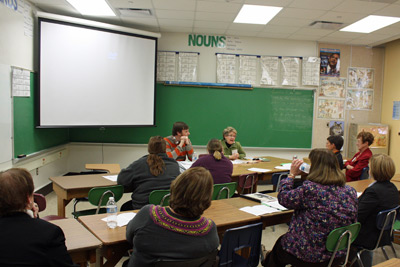 Presenter: Diana Hadley and Rev. David Weatherspoon
Presenter: Diana Hadley and Rev. David Weatherspoon
Professor in Pulliam School of Journalism; Campus Minister, Franklin College
The presenters co-teach a class at Franklin College on non-violence. They discussed nonviolent approaches to conflict and distributed materials on Peace Study Resources, as well as a syllabus they use in their courses.
Be Connected: YouTube, UN, and URWorld
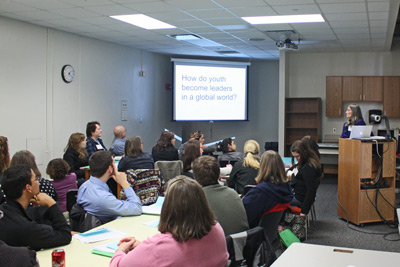 Presenter: Dr. Kathryn De Lawter
Presenter: Dr. Kathryn De Lawter
Assistant Professor, Pace University School of Education
Dr. De Lawter’s presentation was built around the idea that educators may use social media tools to teach globalization while meeting state standards. Social media includes a variety of interactive tools. These tools spark an interest in students and allow them to connect with others. This lets them get more information and other views. Social media “adds value by opening up possibilities not only to be heard but to become a relevant influence.” Students can creatively represent their life issues and search for common ground locally and globally. Using the video projector, Dr. De Lawter shared several online examples, including videos, of student projects. She provided hand-outs that listed numerous sites for additional information and examples. She distributed a hand-out of a “Passport to the Future” of steps. The steps included an action plan with objectives and outcomes. Workshop attendees separated into pairs and created their own “Passport to the Future” plans and shared them with the group.
Exhibitors
KIDS INK
THE CHILDREN’S MUSEUM OF INDIANAPOLIS
THE VILLAGE EXPERIENCE
UNICEF/CTAUN
Steering Committee
Anne-Marie Carlson, Chair
Committee on Teaching About the United Nations (CTAUN)
Faye Snodgress, Executive Director
Kappa Delta Pi, International Honor Society in Education
Anne Boley, Executive Assistant
Kappa Delta Pi, International Honor Society in Education
Patricia Crouch, Main Liaison Representative
American Association of University Women (AAUW)
Dr. Kathryn De Lawter, Assistant Professor
Pace University School of Education
Kirsten Eamon-Shine, Youth Services Director
Peace Learning Center
Dr. B. Welling Hall, Professor, Politics & International Studies
Earlham College
Carol Herzog, Indiana State President
The Delta Kappa Gamma Society International
James Larkin, Assistant Principal
Shortridge Magnet High School for Law & Public Policy
Joanne McGlown, Global Business Development Director
Sigma Theta Tau International Honor Society of Nursing
Sally Rushmore, Managing Editor
Kappa Delta Pi, International Honor Society in Education
Sue Stahl, Director, Student Personnel Services
Butler University
Dr. Nancy Steffel, Coordinator of Elementary Education
University of Indianapolis
Sherry Watkins, State Legislation Chair
The Delta Kappa Gamma Society International
Charlie Wiles, Program Director
International Interfaith Initiative
Supporters
AMERICAN ASSOCIATION OF UNIVERSITY WOMEN
BUTLER UNIVERSITY
THE DELTA KAPPA GAMMA SOCIETY INTERNATIONAL
EARLHAM COLLEGE
INDIANA HUMANITIES COUNCIL
INDIANA UNIVERSITY
INDIANAPOLIS PEACE INSTITUTE
INTERNATIONAL INTERFAITH INITIATIVE
MARIAN UNIVERSITY
THE PACERS FOUNDATION
THE RICHARD G. LUGAR FRANCISCAN CENTER FOR GLOBAL STUDIES
SHORTRIDGE MAGNET HIGH SCHOOL FOR LAW AND PUBLIC POLICY
SIGMA THETA TAU INTERNATIONAL HONOR SOCIETY OF NURSING
UNIVERSITY OF INDIANAPOLIS
